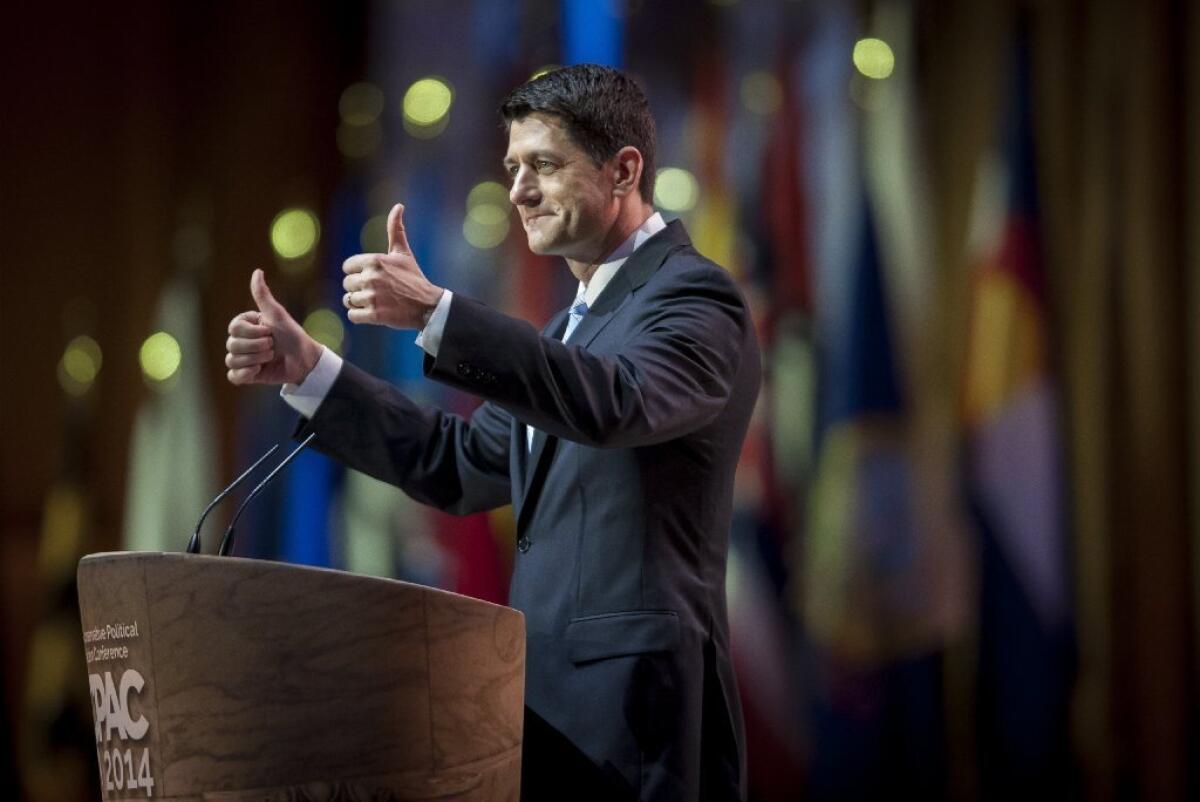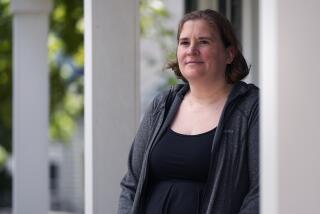Paul Ryan discovers there’s no free lunch

- Share via
Here’s how a heartwarming nonpolitical story about the relationship between a harried executive and a homeless child gets transformed into a frosty political attack on anti-poverty school lunches for children. Your host: Rep. Paul D. Ryan, R-Wisc.
Ryan has just issued a report on America’s War on Poverty programs, arguing that they’re too “duplicative and complex.” He doesn’t explicitly call for cutting them, but he implies they’re wasteful, and the way he plays fast and loose with the details of many of these programs--as we reported here and here--certainly suggests that he’d be happy if they were smaller.
That brings us to the anecdote Ryan told Thursday at the annual conservative hootenanny known as CPAC. He said he’d heard it from Eloise Anderson, head of Wisconsin’s Department of Women and Families. As he told the story:
“She once met a young boy from a very poor family, and every day at school, he would get a free lunch from a government program. He told Eloise he didn’t want a free lunch. He wanted his own lunch, one in a brown-paper bag just like the other kids. He wanted one, he said, because he knew a kid with a brown-paper bag had someone who cared for him.”
In Ryan’s hands, this became a lesson for “the left....What they’re offering people is a full stomach and an empty soul.”
Leaving aside that you can’t eat even a full soul, it turns out that Ryan not only cribbed from Anderson, she appears to have cribbed from the bestselling book “An Invisible Thread,” which is author Laura Schroff’s story of her bond with an 11-year-old panhandler, including her offer to make him lunch every day or give him the money to buy a full lunch. As Wonkette and Washington Post fact-checker Glenn Kessler point out, in the book it’s told this way:
“‘Miss Laura,’ he said, ‘I don’t want your money. I want my lunch in a brown paper bag.’
“‘Okay, sure. But why do you want it in a bag?’
“‘Because when I see kids come to school with their lunch in a paper bag, that means someone cares about them. Miss Laura, can I please have my lunch in a paper bag?’”
So we start with a story about a harried sales executive learning about life from an abandoned child. That gets transformed, via the Republican wringer, into a lesson about the supposedly soul-sapping effect of a government nutritional program, and thence into a reproach to “the left,” which doesn’t care about the souls of our children, only about making sure they’re, you know, fed. This is how the old game of “Telephone” is played in Washington today.
Once outed, Ryan issued an apology of sorts via his Facebook page: “I have just learned that Secretary Anderson misspoke, and that the story she told was improperly sourced. I regret failing to verify the original source of the story, but I appreciate her taking the time to share her insights.”
Well, no. The story Anderson told was fabricated, her “insights” specious.
Speaking to the Huffington Post, Schroff herself observed of Anderson’s version, “In some ways, her account is very similar, but really, it’s drastically different... Maurice describes being hungry as being punched in the stomach. And given the choice between a free lunch and not eating at all, he would choose the free lunch.”
The speciousness of the school lunch story underscores the real issue with Ryan’s approach to anti-poverty programs: He gets them wrong. One of his big points is that these programs create a “poverty trap” that discourages their recipients from working their way out of poverty--by their bootstraps, as it were.
He cites a 2012 Congressional Budget Office report to the effect that the poverty programs impose a marginal tax rate of 100% on some households, which he says works to “penalize families for getting ahead.”
But this is another item from Ryan’s fast-and-loose connection. The hike in marginal tax rates is a well-known artifact of all means-tested programs, whose benefits phase out with rising income. For example, if by earning $1,000 more a recipient loses $1,000 in benefits, that’s effectively a 100% tax on that thousand dollars.
The CBO, however, offered that 100% marginal tax as an extreme case, and showed it would affect a small percentage of families within a fleeting, narrow band of income changes. As you can see in the graphic above, for the most part the rising poor keep between 30% and 80% of their new income, averaging out to 60%-65%. (The marginal tax rate on new income is along the left.)
If Ryan has in mind a better formula to reduce the spike in the $18,000-$20,000 range, let’s hear it--he’s supposed to be good at math. And let’s have no more of this “poverty trap” and “empty soul” nonsense. It’s just an excuse for providing the needy with less--the true sign of an empty soul.
More to Read
Sign up for our Book Club newsletter
Get the latest news, events and more from the Los Angeles Times Book Club, and help us get L.A. reading and talking.
You may occasionally receive promotional content from the Los Angeles Times.








